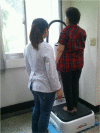Effect of 6 months of whole body vibration on lumbar spine bone density in postmenopausal women: a randomized controlled trial
- PMID: 24348029
- PMCID: PMC3857009
- DOI: 10.2147/CIA.S53591
Effect of 6 months of whole body vibration on lumbar spine bone density in postmenopausal women: a randomized controlled trial
Erratum in
- Clin Interv Aging. 2014;9:945
Abstract
Background: The issue of osteoporosis-induced fractures has attracted the world's attention. Postmenopausal women are particularly at risk for this type of fracture. The nonmedicinal intervention for postmenopausal women is mainly exercise. Whole body vibration (WBV) is a simple and convenient exercise. There have been some studies investigating the effect of WBV on osteoporosis; however, the intervention models and results are different. This study mainly investigated the effect of high-frequency and high-magnitude WBV on the bone mineral density (BMD) of the lumbar spine in postmenopausal women.
Methods: This study randomized 28 postmenopausal women into either the WBV group or the control group for a 6-month trial. The WBV group received an intervention of high-frequency (30 Hz) and high-magnitude (3.2 g) WBV in a natural full-standing posture for 5 minutes, three times per week, at a sports center. Dual-energy X-ray absorptiometry was used to measure the lumbar BMD of the two groups before and after the intervention.
Results: Six months later, the BMD of the WBV group had significantly increased by 2.032% (P=0.047), while that of the control group had decreased by 0.046% (P=0.188). The comparison between the two groups showed that the BMD of the WBV group had increased significantly (P=0.016).
Conclusion: This study found that 6 months of high-frequency and high-magnitude WBV yielded significant benefits to the BMD of the lumbar spine in postmenopausal women, and could therefore be provided as an alternative exercise.
Keywords: osteoporosis; postmenopausal women; whole body vibration.
Figures
Similar articles
-
The combined effect of Parathyroid hormone (1-34) and whole-body Vibration exercise in the treatment of postmenopausal OSteoporosis (PaVOS study): a randomized controlled trial.Osteoporos Int. 2019 Sep;30(9):1827-1836. doi: 10.1007/s00198-019-05029-z. Epub 2019 Jul 15. Osteoporos Int. 2019. PMID: 31309239 Free PMC article. Clinical Trial.
-
Effect of 12 months of whole-body vibration therapy on bone density and structure in postmenopausal women: a randomized trial.Ann Intern Med. 2011 Nov 15;155(10):668-79, W205. doi: 10.7326/0003-4819-155-10-201111150-00005. Ann Intern Med. 2011. PMID: 22084333 Clinical Trial.
-
Effect of Whole-Body Vibration Exercise on Power Profile and Bone Mineral Density in Postmenopausal Women With Osteoporosis: A Randomized Controlled Trial.J Manipulative Physiol Ther. 2020 May;43(4):384-393. doi: 10.1016/j.jmpt.2019.12.003. Epub 2020 Aug 28. J Manipulative Physiol Ther. 2020. PMID: 32868028 Clinical Trial.
-
Effects of whole-body vibration on bone mineral density in postmenopausal women: an overview of systematic reviews.BMC Womens Health. 2024 Aug 6;24(1):444. doi: 10.1186/s12905-024-03290-x. BMC Womens Health. 2024. PMID: 39107743 Free PMC article.
-
Effect of whole-body vibration training on bone mineral density in older adults: a systematic review and meta-analysis.PeerJ. 2025 May 16;13:e19230. doi: 10.7717/peerj.19230. eCollection 2025. PeerJ. 2025. PMID: 40391029 Free PMC article.
Cited by
-
Modulation of bone's sensitivity to low-intensity vibrations by acceleration magnitude, vibration duration, and number of bouts.Osteoporos Int. 2015 Apr;26(4):1417-28. doi: 10.1007/s00198-014-3018-5. Epub 2015 Jan 23. Osteoporos Int. 2015. PMID: 25614140
-
Effects of whole body vibration exercises on bone mineral density of women with postmenopausal osteoporosis without medications: novel findings and literature review.J Musculoskelet Neuronal Interact. 2016 Sep 7;16(3):193-203. J Musculoskelet Neuronal Interact. 2016. PMID: 27609034 Free PMC article.
-
Effect of capsaicin-sensitive sensory neurons on bone architecture and mechanical properties in the rat hindlimb suspension model.J Orthop Translat. 2017 Mar 27;10:12-17. doi: 10.1016/j.jot.2017.03.001. eCollection 2017 Jul. J Orthop Translat. 2017. PMID: 29662756 Free PMC article.
-
Whole-body vibration exercise in postmenopausal osteoporosis.Prz Menopauzalny. 2015 Mar;14(1):41-7. doi: 10.5114/pm.2015.48679. Epub 2015 Mar 25. Prz Menopauzalny. 2015. PMID: 26327887 Free PMC article. Review.
-
Combination treatment with whole body vibration and a kidney-tonifying herbal Fufang prevent osteoporosis in ovariectomized rats.Orthop Surg. 2015 Feb;7(1):57-65. doi: 10.1111/os.12161. Orthop Surg. 2015. PMID: 25708037 Free PMC article.
References
-
- Totosy de Zepetnek JO, Giangregorio LM, Craven BC. Whole-body vibration as potential intervention for people with low bone mineral density and osteoporosis: a review. J Rehabil Res Dev. 2009;46(4):529–542. - PubMed
-
- Lane NE. Epidemiology, etiology, and diagnosis of osteoporosis. Am J Obstet Gynecol. 2006;194(Suppl 2):S3–S11. - PubMed
Publication types
MeSH terms
LinkOut - more resources
Full Text Sources
Other Literature Sources
Medical



